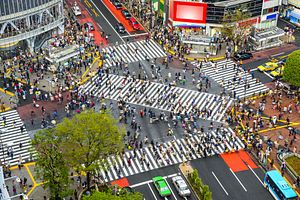Asia’s urbanization may only be just beginning, despite almost 200 million people moving to its cities in the first decade of the 21st century, according to the World Bank.
The mass movement of people to East Asia’s cities was the equivalent size of the world’s sixth-largest country, the Washington-based institution said in a report released January 26.
Importantly for the region’s economic potential, the overall proportion of urbanites rose only slightly, increasing from 29 percent to 36 percent over the same period. This shows the potential for “more decades of urban growth to come,” spurring the continued growth of Asia’s emerging middle class due to the “direct link between urbanization and income growth.”
East Asia’s total urban population increased from 579 million in 2000 to 778 million in 2010, more than two times greater than second-largest Europe. According to the report, it took more than 50 years for the same number of people to become urbanized in Europe, indicating Asia’s rapid growth.
The region’s cities have also become more densely populated, rising from 5,400 to 5,800 people per square kilometer as of 2010, led by Hong Kong’s 32,000 people per square kilometer. Overall, East Asia’s population density grew to more than 1.5 times the average for the world’s urban areas and more than 50 times the average density in the United States.
Yet while East Asia’s urban land area expanded from 106,400 to 134,800 square kilometers over the same period, less than 1 percent of the region’s total land area remains urbanized.
China accounted for two-thirds of the growth in urban land and more than 80 percent of urban expansion in the region, with its 477 million urban inhabitants in 2010 larger than the rest of the region combined. Japan had the second-highest total amount of urban land and the third-largest urban population, but showed slow rates of expansion overall, except for the extra 4 million Tokyoites over the decade.
The report said the fastest annual rates of urban expansion were in the developing economies of Laos and Cambodia (7.3 percent and 4.3 percent, respectively), followed by China (3.1 percent) and Vietnam (2.8 percent).
China’s Pearl River Delta, encompassing the cities of Dongguan, Foshan, Guangzhou and Shenzhen, grew to encompass 42 million people – larger than the population of countries such as Australia and Malaysia, and overtaking Tokyo as the largest urban area in the world based on size and population.
The Pearl River Delta was among eight megacies of more than 10 million people in East Asia, including China’s Beijing (17 million) and Shanghai (24 million), Japan’s Osaka-Kobe (12 million) and Tokyo (32 million), and the cities of Jakarta (23 million), Manila (16.5 million) and Seoul (16 million).
However, despite the rise of the megacities, two-thirds of the region’s urban areas are comprised of 100,000 to 500,000 people, with the biggest growth in urban population occurring in medium-sized areas. This has resulted in increasing metropolitan fragmentation, with almost 350 urban areas spilling over local administrative boundaries.
While the report said East Asia’s urbanization had largely been driven by market forces, it said policymakers had an important role in facilitating land access and ensuring economic efficiencies, while reducing income inequalities.
According to the Asian Development Bank (ADB), while the region has halved the number of people living in extreme poverty and increased average per capita income by about 6 percent from 1990 to 2010, the larger economies have seen a “widening divide between the rich and the poor.”
“In two decades of spectacular economic growth and poverty reduction, Asia has nonetheless seen income inequality rising by more than 20 percent – a growth pattern that cannot be considered inclusive,” the ADB’s Vinod Thomas said. “A shift to more inclusive growth that taps the contribution of people at all income levels, not just the better-off, would not only be socially desirable but also help sustain growth itself.”
Tokyo ‘World’s Safest’
Asia’s rapid urbanization has also led to improved public safety, which according to The Economist is “closely linked to wealth and economic development.”
In its latest Safe Cities Index 2015, the Economist Intelligence Unit rated Tokyo as the most populous but also the safest city among the 50 surveyed worldwide, followed by Singapore and Osaka.
The Japanese capital ranked highest in the digital security category, as well as being in the top five for personal and infrastructure safety, “despite suffering regular earthquakes and being home to the world’s largest urban population.”
The Australian cities of Sydney and Melbourne also ranked highly, in sixth and ninth place respectively, while Hong Kong placed 11th and Taipei 13th among those from the Asia-Pacific region.
Among China’s biggest cities, Shanghai in 30th place was the best performer, while in India, Delhi and Mumbai ranked 42nd and 44th, respectively. However, Jakarta ranked last, with its highest ranking in health security (44th).
Apart from Australia, the region’s cities suffered poor rankings in the “livability” index, with Osaka the highest at 15th followed by Tokyo in 16th spot and Taipei at 21st. Melbourne gained bragging rights over its northern neighbour, securing sixth spot compared to Sydney’s ninth.
The report urged greater action to improve safety in developing countries, noting the potential economic benefit for businesses.
“Businesses in fast-growing markets have a clear economic interest in a safe city, populated with contented consumers untroubled by cybercrime and healthy and productive workers breathing clean air in green open spaces,” the report said.
“Ultimately, in mature and emerging cities alike, local governments and city leaders need to get better at collaborating with all city stakeholders from different departments, sectors and civil society groups. The arguments for taking such measures are compelling when most of the world now calls a city their home.”
With Asia’s urbanization set to continue, the economic and commercial imperative to improve its cities has never been greater.
































